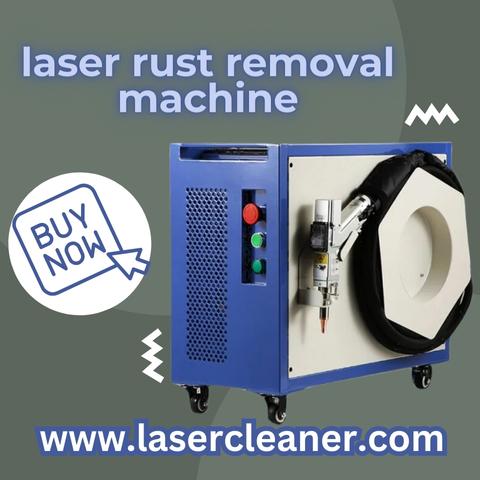Rust removal has always been a critical task in maintaining the longevity and functionality of metal surfaces. Traditional methods like sandblasting, chemical treatments, or manual scraping often come with drawbacks such as environmental hazards, surface damage, or extensive labor. The emergence of laser rust removal machine has revolutionized this process by introducing a precise, efficient, and cleaner alternative. This article explores how these machines work, their operation principles, applications, and why they are becoming a preferred choice in various industries.
Understanding Laser Rust Removal Machines
A laser rust removal machine uses highly focused laser beams to eliminate rust and other surface contaminants from metal objects. Unlike abrasive or chemical methods, the laser targets the rust layer specifically without affecting the underlying metal. This precision is a key factor that sets laser cleaning apart.
The machine emits pulses of laser light at a specific wavelength and energy density, which interacts with the rust layer. Rust, primarily iron oxide, absorbs the laser energy, heats up rapidly, and subsequently vaporizes or flakes off from the metal surface. The underlying metal, which has different absorption properties and thermal conductivity, remains intact and unharmed.
How Does It Clean Without Damaging Metal?
The trick lies in the difference in laser absorption between rust and metal. Rust absorbs laser energy more efficiently than the metal beneath it. When the laser pulses hit the surface, the rust heats up instantly and breaks down into tiny particles or gas, which are then removed by suction systems or natural air flow.
Because the metal substrate reflects more of the laser energy and has higher thermal conductivity, it dissipates heat quickly and avoids reaching temperatures that cause damage. The laser cleaning process is therefore highly controlled, ensuring only the unwanted rust layer is affected.
The Process of Laser Rust Removal
-
Preparation: The metal surface is inspected to determine the extent of rust. Based on the material type and rust thickness, the laser settings are adjusted.
-
Laser Scanning: The laser beam is guided over the rusted area using a movable head or robotic arm. The beam's parameters—such as pulse duration, frequency, and power—are optimized for maximum rust removal efficiency.
-
Rust Removal: As the laser pulses strike the surface, the rust absorbs energy, vaporizes, and detaches from the metal. The removed particles are usually captured by an integrated vacuum or filtration system to maintain a clean environment.
-
Inspection: After the laser cleaning, the surface is checked for complete rust removal and any residual contamination. If necessary, additional passes are performed.
Industries Benefiting from Laser Rust Removal Machines
Various industries have integrated laser rust removal technology into their maintenance and manufacturing processes due to its precision and environmental friendliness:
-
Automotive: Cleaning rust from vehicle parts before painting or repair.
-
Shipbuilding: Removing corrosion from ship hulls and metal components.
-
Aerospace: Preparing aircraft parts for inspection and repainting.
-
Manufacturing: Maintaining machinery and tools by rust removal without dismantling.
-
Heritage Conservation: Cleaning historical metal artifacts without damaging their integrity.
Why Laser Rust Removal Is a Game Changer
The method's precision enables cleaning in areas difficult to reach with conventional tools. Additionally, because it avoids abrasive contact, the metal’s original surface texture and properties remain unaltered. There are no chemical residues left behind, and the process is less labor-intensive, which contributes to operational efficiency.
The speed of rust removal with lasers is significantly higher than manual methods. This efficiency translates into less downtime for equipment and faster turnaround times in production and maintenance cycles.
Safety and Environmental Aspects
Using a laser rust removal machine minimizes the use of harmful chemicals, reducing hazardous waste disposal concerns. The absence of abrasive materials also lowers dust and particulate pollution, contributing to a cleaner working environment.
Proper safety measures are essential when operating laser equipment, including protective eyewear, ventilation systems, and trained personnel to handle the machinery safely.
Maintenance and Operational Considerations
Operating a laser rust removal machine requires some expertise to optimize settings based on the metal type and rust severity. Regular maintenance of the laser source, optics, and vacuum systems ensures consistent performance. The durability of these machines varies with usage intensity and quality but generally offers a good return on investment due to reduced labor and increased productivity.
Economic Impact
Though the initial investment in a laser rust removal machine may be higher than traditional tools, the long-term savings in time, labor, material conservation, and environmental compliance make it a cost-effective solution. Businesses adopting this technology can improve their competitive edge by maintaining higher-quality outputs and faster service times.
Final Thoughts
A laser rust removal machine represents a significant advancement in metal surface maintenance technology. Its ability to precisely and safely remove rust without harming the underlying metal makes it ideal for various industrial applications. By leveraging laser technology, businesses can enhance efficiency, reduce environmental impact, and maintain superior quality in metal care processes. As industries continue to seek cleaner and more effective solutions, laser rust removal machines are poised to become a standard in rust management.

